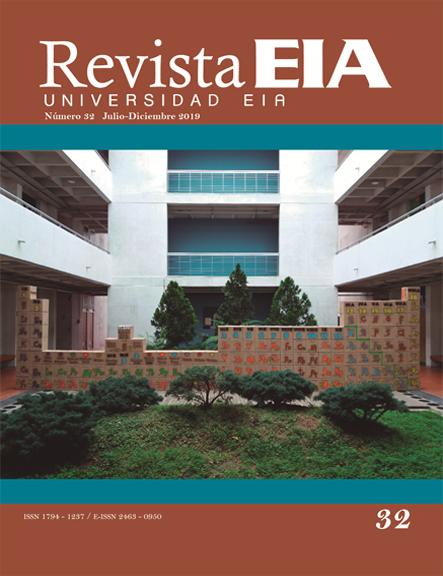Índice de vulnerabilidad sísmica de escuelas del Área Metropolitana de Medellín, Colombia
Índice de vulnerabilidad sísmica de escuelas del Área Metropolitana de Medellín, Colombia

Copyright statement
The authors exclusively assign to the Universidad EIA, with the power to assign to third parties, all the exploitation rights that derive from the works that are accepted for publication in the Revista EIA, as well as in any product derived from it and, in in particular, those of reproduction, distribution, public communication (including interactive making available) and transformation (including adaptation, modification and, where appropriate, translation), for all types of exploitation (by way of example and not limitation : in paper, electronic, online, computer or audiovisual format, as well as in any other format, even for promotional or advertising purposes and / or for the production of derivative products), for a worldwide territorial scope and for the entire duration of the rights provided for in the current published text of the Intellectual Property Law. This assignment will be made by the authors without the right to any type of remuneration or compensation.
Consequently, the author may not publish or disseminate the works that are selected for publication in the Revista EIA, neither totally nor partially, nor authorize their publication to third parties, without the prior express authorization, requested and granted in writing, from the Univeridad EIA.
Show authors biography
En este trabajo se presenta la evaluación de la vulnerabilidad sísmica de un inventario de escuelas ubicadas en las ciudades de Medellín, Itagüí y Sabaneta, Colombia, a través de la aplicación del método del Índice Prioritario desarrollado por Hassan y Sözen (1997). El procedimiento del Índice Prioritario permite identificar, de un grupo de estructuras de pórticos de hormigón reforzado, aquellas que podrían sufrir daño severo o colapso en caso de un evento sísmico importante y, por lo tanto, requieren de una evaluación de vulnerabilidad sísmica detallada. Se evaluaron un total de 82 estructuras pertenecientes a 30 instituciones educativas. El sistema de resistencia a cargas laterales de todas las estructuras evaluadas corresponde a pórticos de hormigón reforzado con presencia de muros de mampostería. La aplicación del método del Índice Prioritario identificó un 61% de las estructuras analizadas como prioritarias, es decir, con posibilidad de que sufran daño severo o colapso ante un futuro evento sísmico. En el desarrollo de esta investigación se propuso incluir parámetros adicionales al método para la evaluación de las estructuras: año de construcción y presencia de columnas cortas. Finalmente, se identificó un 60% de las estructuras con prioridad alta; este alto porcentaje implica que una gran cantidad de menores estarían en alto riesgo ante la ocurrencia de un evento sísmico.
Article visits 1592 | PDF visits 874
Downloads
- Asociación Colombiana de Ingeniería Sísmica-AIS, “Reglamento Colombiano de Construcción Sismo Resistente NSR-10”, Bogotá: AIS, 2010.
- Asociación Colombiana de Ingeniería Sísmica-AIS, “Código Colombiano de Construcción Sismo Resistente CCCSR-84”, Bogotá: AIS, 1984.
- Asociación Colombiana de Ingeniería Sísmica-AIS, “Reglamento Colombiano de Construcción Sismo Resistente NSR-98”, Bogotá: AIS, 1998.
- Consorcio Microzonificación 2006, Área Metropolitana del Valle de Aburrá, “Microzonificación y Evaluación del Riesgo Sísmico del Valle de Aburrá”, Medellín: Prográficas Ltda, 184p, 2007.
- Coronel, G., “Estimación de Daños y Pérdidas Debidas a Terremotos en Escenarios Regionales: Aplicación a Edificaciones Escolares de Venezuela”, Proyecto de Grado de Maestría en Ingeniería Sismo resistente, Universidad Central de Venezuela, Caracas, Venezuela 2012.
- Coronel, G., López, O.A., “Regional Seismic Damage, Loss and Risk Scenearios of Venezuelan School Buildings”, In: Proceedings of the Fifthteenth World Conference on Earthquake Engineering, Lisbon, Portugal, 2012.
- Departamento Administrativo Nacional de Estadística-DANE, “Censo General 2005-República de Colombia, Bogotá, 2005.
- Dönmez, C., Pujol, S., “Spatial Distribution of Damage Caused by the 1999 Earthquakes in Turkey”, Earthquake Spectra, 21(1): 53-69, 2005.
- Hassan, A., Sözen, A., “Seismic Vulnerability Assessment of Low-Rise Buildings in Regions with Infrequent Earthquakes”, In: ACI Structural Journal, 94(1): 31-19, 1997.
- National strong-motion network of Turkey (TR-NSMN), Duzce-Meteoroloji Mudurlugu Station, (Online), (Cited: 12 nov.2013), <http://www.isesd.hi.is/esd_local/cdrom/reports/SR553.htm>.
- National strong-motion network of Turkey (TR-NSMN), Erzincan-Meteorologij Mudurlugu Station, (Online), (Cited: 12 nov.2013), < http://www.isesd.hi.is/esd_local/cdrom/reports/SR205.htm>.
- O’brien, P., Eberhard, M., Haraldsson, O., Irfanoglu, A., Lattanzi, D., Laurer, S., Pujol, S., “Measures of the Seismic Vulnerability of Reinforced Concrete Buildings in Haití”, Earthquake Spectra, 27(S1): 373-386, 2011.
- Ren, Y., Wen, R., Chen, G., “Using Numerical Simulation Via Wave Finite Element Method to Study the Effect of the Station Surrounding on the Strong-Motion Recordings”, Institute of Engineering Mechanics, China Earthquake Administration, Harbin, Recent Advances in CSIE 2011, LNEE 126, pp. 353-359, 2012.
- Shiga, T., Shibata, A., Takahashi, T., “Earthquake Damage and Wall Index of Reinforced Concrete Buildings”, In: Proceedings, Tohuku District Symposium (In Japanese), Architectural Institute of Japan, 12: 29-32, 1968.
- Sözen, A., “Surrealism in Facing the Earthquake Risk, In: Seismic Evaluation and Rehabilitation of Structures”, 26: 1-13, 2014.
- TUBITAK and NSF (teams of engineers), “1 May 2003 Bingöl Earthquake Engineering Report”, Scientific and Technical Research Council of Turkey (TUBITAK) and U.S. National Science Foundation (NSF), 140p, 2003.
- United Nations Centre for Regional Development UNCRD. (2009). Reducing vulnerability of school children to earthquakes. A project of School Earthquake Safety Initiative (SESI). http://www.preventionweb.net/files/2951_SESIOutcomeallfinal.pdf
- U.S. Geological Survey USGS, “13 March 1992 Erzincan”, Turkey, Earthquake Shake-Map, Atlas N° 199203131718, 1992, (Online), (Cited: 10 oct.2013), <http://earthquake.usgs.gov/earthquakes/shakemap/atlas/shake/199203131718/>.
- U.S. Geological Survey USGS, “12 November 1999 Düzce”, Turkey, Earthquake Shake-Map, Atlas N° 199911121657, 1999, (Online), (Cited: 10 oct.2013), <http://earthquake.usgs.gov/earthquakes/shakemap/atlas/shake/199911121657>.
- U.S. Geological Survey USGS, “1 May 2003 Bingöl”, Turkey, Earthquake Shake-Map, Atlas N° 200305010027, 2003, (Online), (Cited: 15 oct.2013), <http://earthquake.usgs.gov/earthquakes/shakemap/atlas/shake/200305010027/>.
- U.S. Geological Survey USGS, “12 May 2008 Sichuan”, China, Earthquake Shake-Map, Atlas N° us2008ryan, 2010, (Online), (Cited: 15 0ct.2013), <http://earthquake.usgs.gov/earthquakes/shakemap/global/shake/2008ryan/ >.
- U.S. Geological Survey USGS, “12 January 2010 Haiti”, Earthquake Shake-Map, Atlas N° us2010rja6, 2008, (Online), (Cited: 20 feb.2013), <http://earthquake.usgs.gov/earthquakes/shakemap/global/shake/2010rja6/ >.
- Zhou, W., Zheng, W., Pujol, S., “Seismic Vulnerability of Reinforced Concrete Structures affected by the 2008 Wenchuan Earthquake”, In: <https://nees.org/warehouse>, 21p, 2013.




